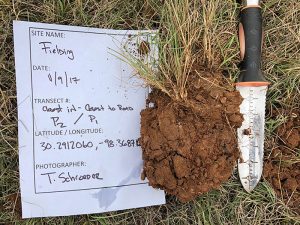By Stephanie Kasper, University of Texas Rio GraSoil for Waternde Valley Program Manager
As a south Texas farmer, there’s not much I love more than a refreshing rainy day. However, my rain appreciation grew deeper this year after my partner John and I installed a 1,650-gallon rain harvest system at our house.
After moving into our home just outside Edinburg city limits in February 2022, we replaced most of our turf grass with a 336-square-foot vegetable garden in the front yard and an 840-square- foot one in the back, surrounded by vibrant native wildflowers.
The transformation from a lawn to food-producing gardens brought us both joy and water savings. Drought-adapted native plants require less water than traditional grass lawns, and we use drip irrigation for the vegetables, which is more efficient than overhead sprinklers. However, we wanted to reduce our reliance on the municipal water supply for outdoor plants even further, and help save the cleanest, highest-quality water for human consumption.
This desire felt ever more pressing as we settled into another hot, dry south Texas summer. Falcon Reservoir, which supplies water to the Rio Grande Valley, reached a historic low of 9% capacity in August 2022, leading to water use restrictions. Frustrated by complex water management issues and worried about our region’s long-term water supplies, I channeled that energy into action at home. I mapped my roof’s runoff potential and natural drip points, gathered supplies from Lowes, found six food-grade, 275-gallon IBC totes on Facebook Marketplace (with free delivery!), and studied YouTube videos on gutter installations.
The first rainfall after installing the gutters and tanks had me running from tank to tank, blissfully soaked, watching the water pour in. Even after nearly a year, I’m still out there for nearly every rainfall, happily watching the tanks fill and clearing any debris blocking the water flow.
A rain harvester rule of thumb is that 1 inch of rain on 1 square foot yields 0.6 gallons of potential water capture. With a roof area of 2,000 square feet and an average of 23 inches of rain in Edinburg per year, over 27,000 gallons of water flow off my roof annually. My 1,650-gallon tank storage can be filled entirely with just 1.5 inches of rain.
I arranged the tanks based on the flow rates of each roof section and with the destinations for water use in mind – two tanks in the front yard for the smaller front garden and four in the back for the larger backyard garden. The two front yard tanks are located at natural drip points, where 438 square feet of roof runoff can be channeled into them without additional gutter installations. These natural drip points are the easiest entry point for rain harvesting.
Once the rainwater is collected, the key is to use it efficiently. We use a 12V plug-in water pump to send water directly into the existing garden drip irrigation systems, eliminating the need for manual water hauling. The front yard drip irrigation uses 1.3 gallons per minute, so the 550 gallons of stored rainwater can provide about seven hours of irrigation time. The backyard system, with a water use rate of 2 gallons per minute and 1,100 gallons of water storage, provides nine hours of irrigation time.
In the past year, the stored water has helped reduce our municipal water use even further. The front yard garden required supplemental city water for only 50 out of 365 days (14%), and the back yard needed it for 153 out of 365 days (42%), with the gardens collectively producing 148 pounds of food in that time. Our city water usage came mostly during a 97-day dry stretch between late December and late March, when we received a total of only 0.5 inches of scattered rainfall. Since the backyard system was not complete until midway through last year, I expect our city water needs to decrease even further next year. The system is modular, and we can add additional tanks to increase water storage capacity based on our needs, providing flexibility for the future.
Installing a rain harvest system takes planning, funds, and maintenance, and I’m not going to suggest that it’s an easy sustainability swap that’s right for everyone. I’ve only saved a few dollars each month on my water bill at most. However, it has given me confidence in the resilience of our food-producing gardens amid heat waves and droughts and made me a more conscious water user.
Rainwater harvesting is already supported in Texas through exemptions from state sales tax on equipment and supplies. Some cities, like San Antonio and Austin, also offer educational programming and rainwater storage rebate programs to encourage rain harvesting. However, more efforts are required to promote rainwater harvesting on a larger scale, especially as Texas stares down the impacts of climate change and prepares for significant potential water shortfalls by 2040. Confronting these challenges in the Rio Grande Valley and beyond must include a reconsideration of our relationship with water, in small ways and large, to secure a sustainable future for all.
Related NCAT Resources:
Drought and Disaster Resources for Texas Producers
The Texas Irrigator’s Pocket Guide
Managing Soils for Water: How Five Principles of Soil Health Support Water Infiltration and Storage
Soil Moisture Monitoring: Low-Cost Tools and Methods
Other Resources:
Agroecology and Resilient Food Systems, University of Texas Rio Grande Valley



